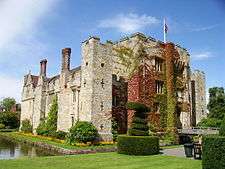Hever Castle
| Hever Castle | |
|---|---|
| Hever, Edenbridge, Kent | |
|
Hever Castle | |
 Hever Castle | |
| Coordinates | grid reference TQ478452 |
| Type | Castle |
| Site information | |
| Owner | Broadland Properties |
| Open to the public | Yes |
| Condition | Intact |
Hever Castle is located in the village of Hever, Kent, near Edenbridge, 30 miles (48 km) south-east of London, England. It began as a country house, built in the 13th century. From 1462 to 1539 it was the seat of the Boleyn, originally 'Bullen', family.[1]
Anne Boleyn, the second queen consort of King Henry VIII of England, spent her early youth there, after her father, Thomas Boleyn had inherited it in 1505. He had been born there in 1477, and the castle passed to him upon the death of his father, Sir William Boleyn. It later came into the possession of King Henry's fourth wife, Anne of Cleves. In the 21st century the castle is a tourist attraction.
History
There have been three main periods in the construction of this historic castle. The oldest part of the castle dates to 1270 and consisted of the gatehouse and a walled bailey. The second period was when the castle, then in need of repair, was converted into a manor in 1462 by Geoffrey Boleyn, younger brother of Thomas Boleyn, Master of Gonville Hall, Cambridge. He added a Tudor dwelling within the walls. The third period of repair and renovation was in the 20th century when it was acquired by William Waldorf Astor.[2]
Geoffrey's grandson, Thomas Boleyn, inherited the castle in 1505. He lived there with his wife Lady Elizabeth Howard and their children George, Mary and Anne (the future wife of Henry VIII). It is not known if Anne was born at Hever (the year of her birth is not certain) but she lived there until she was sent to the Netherlands in 1513 to receive an education at the court of the Archduchess Margaret.
Henry VIII often used the nearby Bolebroke Castle to conduct his courtship with Anne.
The property came into the possession of Henry VIII after the death of Anne's father, Thomas Boleyn, in 1539. He bestowed it upon Anne of Cleves in 1540 as part of the settlement following the annulment of their marriage. Hever Castle still has one of Henry's private locks, taken with him on his various visits to noblemen's houses and fitted to every door for his security.[3]
The building subsequently passed through various owners, including the Waldegrave family in 1557 and the Meade Waldo family from 1749 to 1903. During this latter period of ownership the castle fell into a poor state of repair, during which time it was leased to various private tenants. In 1903 it was acquired and restored by the American millionaire William Waldorf Astor, who used it as a family residence.[4] He added the Italian Garden to display his collection of statury and ornaments.[5] Since 1983 the castle has been owned by Broadland Properties Limited. The estate is now run as a conference centre, but the castle and grounds are open to the public.
Attractions for tourists
Hever Castle is now a tourist attraction, drawing on its links to Anne Boleyn and Henry VIII, its mazes, gardens and lake. There is an annual events programme with assorted events including jousting tournaments and archery displays in the summer months and an annual patchwork and quilting exhibition in September. The castle has also become the venue for a triathlon.[6] The Castles to Country Houses exhibition contains a collection of 1/12 scale model houses ranging from the medieval to Victorian periods.
The castle offers three floors containing antique furniture, Anne Boleyn's prayer books, instruments of torture, and a large collection of Tudor paintings. There is also a museum of the Kent Yeomanry. The remains of the original country house timbers can still be seen within the stone walls of the fortification, while the gatehouse is the only original part of the castle. It has the oldest working original portcullis in England.[7]
The grounds of the castle include a yew maze, planted in 1904. There is also a water maze, opened in 1999, the object of which is to get to the folly at the centre without getting wet, while in the children's adventure playground there is a tower maze. The castle gardens contain a wide range of features including an Italianate garden (including Fernery), rose gardens, a herb garden, and topiary.
Gallery
- Hever Castle
 Hever Castle - side view
Hever Castle - side view The water maze
The water maze- A bridge over the lake
- One of the rose gardens
 Statue in the castle grounds
Statue in the castle grounds Another statue in the castle grounds
Another statue in the castle grounds- Cottages near the castle
- Italian Gardens
- Loggia with fountain
See also
References
- ↑ Jenkins, Simon (2003). Discover Britain's historic houses. The Southeast. Pub. Reader's Digest. ISBN 0-276-44068-4. P. 43.
- ↑ "Castle". Hever Castle and Gardens. Hever Castle and Gardens.
- ↑ Jenkins, Simon (2003). Discover Britain's historic houses. The Southeast. Pub. Reader's Digest. ISBN 0-276-44068-4. P. 45.
- ↑ John Turner, ‘Astor, William Waldorf, first Viscount Astor (1848–1919)’, rev. Oxford Dictionary of National Biography, Oxford University Press, 2004;
- ↑ Brown, Jane (1999). The English Garden Through the 20th Century. England: Garden Art Press. ISBN 1870673298.
- ↑ Hever Castle Triathlon website
- ↑ Hever Castle at Pastscape
External links
| Wikimedia Commons has media related to Hever Castle. |
Coordinates: 51°11′14″N 0°6′51″E / 51.18722°N 0.11417°E
